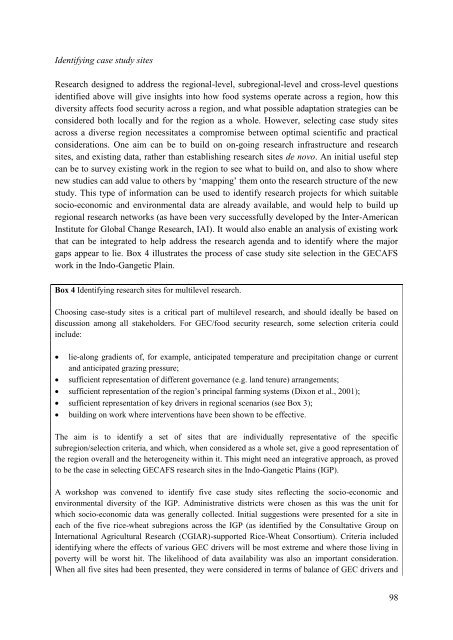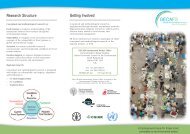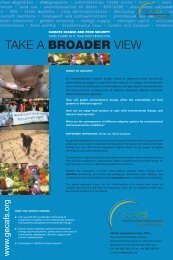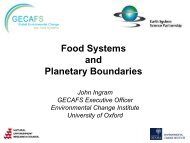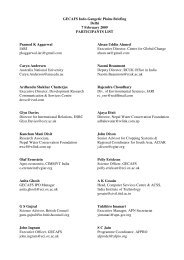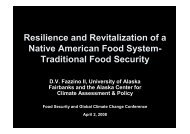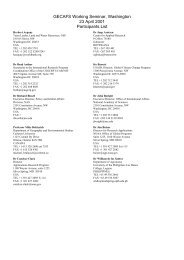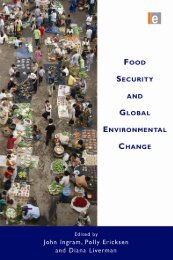From Food Production to Food Security - Global Environmental ...
From Food Production to Food Security - Global Environmental ...
From Food Production to Food Security - Global Environmental ...
- No tags were found...
You also want an ePaper? Increase the reach of your titles
YUMPU automatically turns print PDFs into web optimized ePapers that Google loves.
Identifying case study sitesResearch designed <strong>to</strong> address the regional-level, subregional-level and cross-level questionsidentified above will give insights in<strong>to</strong> how food systems operate across a region, how thisdiversity affects food security across a region, and what possible adaptation strategies can beconsidered both locally and for the region as a whole. However, selecting case study sitesacross a diverse region necessitates a compromise between optimal scientific and practicalconsiderations. One aim can be <strong>to</strong> build on on-going research infrastructure and researchsites, and existing data, rather than establishing research sites de novo. An initial useful stepcan be <strong>to</strong> survey existing work in the region <strong>to</strong> see what <strong>to</strong> build on, and also <strong>to</strong> show wherenew studies can add value <strong>to</strong> others by ‘mapping’ them on<strong>to</strong> the research structure of the newstudy. This type of information can be used <strong>to</strong> identify research projects for which suitablesocio-economic and environmental data are already available, and would help <strong>to</strong> build upregional research networks (as have been very successfully developed by the Inter-AmericanInstitute for <strong>Global</strong> Change Research, IAI). It would also enable an analysis of existing workthat can be integrated <strong>to</strong> help address the research agenda and <strong>to</strong> identify where the majorgaps appear <strong>to</strong> lie. Box 4 illustrates the process of case study site selection in the GECAFSwork in the Indo-Gangetic Plain.Box 4 Identifying research sites for multilevel research.Choosing case-study sites is a critical part of multilevel research, and should ideally be based ondiscussion among all stakeholders. For GEC/food security research, some selection criteria couldinclude: lie-along gradients of, for example, anticipated temperature and precipitation change or currentand anticipated grazing pressure; sufficient representation of different governance (e.g. land tenure) arrangements; sufficient representation of the region’s principal farming systems (Dixon et al., 2001); sufficient representation of key drivers in regional scenarios (see Box 3); building on work where interventions have been shown <strong>to</strong> be effective.The aim is <strong>to</strong> identify a set of sites that are individually representative of the specificsubregion/selection criteria, and which, when considered as a whole set, give a good representation ofthe region overall and the heterogeneity within it. This might need an integrative approach, as proved<strong>to</strong> be the case in selecting GECAFS research sites in the Indo-Gangetic Plains (IGP).A workshop was convened <strong>to</strong> identify five case study sites reflecting the socio-economic andenvironmental diversity of the IGP. Administrative districts were chosen as this was the unit forwhich socio-economic data was generally collected. Initial suggestions were presented for a site ineach of the five rice-wheat subregions across the IGP (as identified by the Consultative Group onInternational Agricultural Research (CGIAR)-supported Rice-Wheat Consortium). Criteria includedidentifying where the effects of various GEC drivers will be most extreme and where those living inpoverty will be worst hit. The likelihood of data availability was also an important consideration.When all five sites had been presented, they were considered in terms of balance of GEC drivers and98


